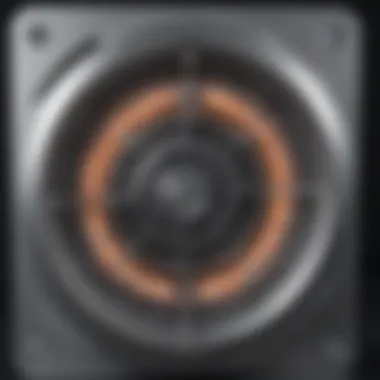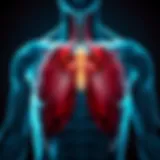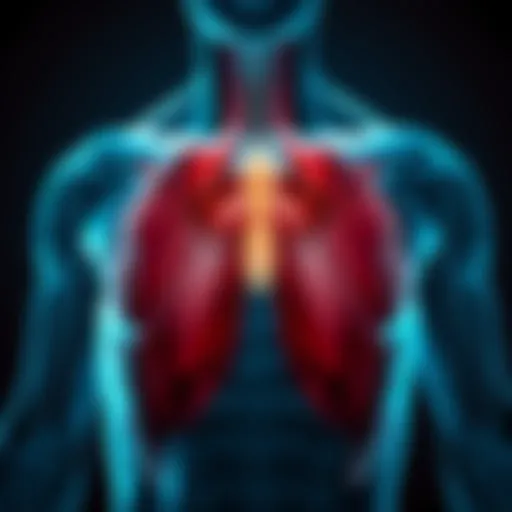Advancements in Ventilator Simulators for Healthcare


Intro
Ventilator simulators play a crucial role in the modern medical landscape, where respiratory management is integral to patient care. The application of these simulators in training healthcare professionals has evolved leaps and bounds over the last several decades. They not only provide a safe environment to practice but also prepare clinicians for high-stakes scenarios.
The need for robust training tools stems from the complexity of ventilator management, which has made its way to the forefront, especially in critical care settings like ICU and ER. With the advancements in medical technology, the dialogue around ventilator simulators has transformed, emphasizing their design, functionality, and broader implications for education and patient outcomes. This article aims to navigate through the landscape of these vital tools in healthcare, unpacking their significance and exploring case studies showcasing real-world applications.
The focus will also be on understanding the technological innovations that have made these simulators more intuitive and reflective of contemporary clinical practice. Researchers, educators, and practitioners will find insights into how these simulators enhance educational strategies and emergency preparedness protocols, making a notable impact on both learning and healthcare delivery.
As we venture through this exploration, we will highlight key advancements in technology, dissect various implementations of ventilator simulators, and discuss how these tools can pave the way for better-trained professionals and improved patient outcomes. Let's dive deeper into this fascinating subject and uncover the layers of technology that make ventilator simulators an invaluable asset in healthcare today.
Understanding the Concept of Ventilator Simulators
Ventilator simulators serve as crucial tools in the realm of healthcare education and training. They provide a hands-on experience that enhances the learning process for medical professionals, particularly those dealing with respiratory therapy and critical care. The significance of understanding these simulators lies in their potential to bridge theoretical knowledge with practical application, ensuring that healthcare providers are well-prepared to handle real-world scenarios.
Definition and Purpose
At their core, ventilator simulators are sophisticated devices designed to mimic the functions of a mechanical ventilator. Their primary purpose is to assist in the training of healthcare providers by recreating various clinical scenarios. These simulators allow users to practice, learn, and refine their skills in a controlled environment without risking patient safety.
By using these simulators, healthcare professionals can familiarize themselves with the mechanics of ventilation, including parameters like tidal volume, pressure settings, and respiration rates. Simulators also offer a platform for learners to engage with unexpected situations, such as a patient’s sudden deterioration. In many ways, they are the next best thing to clinical experience, providing a safe space to build competence and confidence before entering high-pressure environments like emergency rooms or intensive care units.
Historical Context and Development
The development of ventilator simulators isn't an overnight tale. It has is steeped in a rich history of advancements in both technology and medical education. Initially, routine training utilized static models, which forced users to rely heavily on textbook knowledge. As medical understanding progressed, these basic models evolved, but they still lacked the dynamic capabilities required for effective learning.
With the introduction of computer technology in the late 20th century, ventilator simulators began to take shape as we know them today. The early models focused primarily on basic functionalities and did not incorporate real-time feedback. However, advancements in software and hardware drastically improved these simulators, leading to a new era in medical training.
Gone are the days when learners had to imagine various scenarios. Now, simulators can replicate a host of conditions and incorporate real-time changes, making the training experience far more engaging and informative. The rise of affordable high-quality simulators has empowered numerous institutions to integrate them into their curricula, revolutionizing how ventilator management is taught.
"The future of medical training lies in innovation and practical experience. Ventilator simulators embody this shift, merging technology with education."
Overall, as the field of ventilator technology continues to evolve rapidly, keeping pace with these changes in simulation effectively prepares healthcare professionals for the tasks they will face in actual clinical settings.
Types of Ventilator Simulators
In the realm of medical training, the concept of ventilator simulators serves as a critical cornerstone. These tools are designed to mimic the respiratory support given to patients, enabling learners to practice and refine their skills in a risk-free environment. The significance of categorizing these simulators into basic, advanced, and customizable settings allows for a tailored approach to learning, ensuring that healthcare professionals can acquire the necessary competencies to manage real-life situations effectively.
Basic Simulators
Basic ventilator simulators are the entry-level tools in this category. These simulators focus primarily on the fundamental aspects of ventilation. They provide a simplified interface and basic functionality, allowing users to grasp essential breathing patterns and ventilator settings. The benefit here lies in their straightforward design, making it easier for novices to understand ventilatory support.
These simulators often emphasize:
- Simple Controls: Users can adjust parameters such as tidal volume and respiratory rate without overwhelming complexities.
- Foundational Breathing Patterns: They offer a limited range of scenarios but are effective in teaching core concepts of ventilation.
- Cost-Effectiveness: Ideal for educational institutions operating on a limited budget, these simulators provide a low-investment option for teaching basic skills.
Advanced Simulators
In contrast, advanced ventilator simulators present a cutting-edge approach to respiratory education. These sophisticated tools incorporate a vast array of features, including real-time feedback and complex physiological responses, which closely represent actual patient scenarios.
Advantages of using advanced simulators include:
- High Fidelity: They offer realistic patient interactions with varying clinical conditions, allowing users to experience diverse challenges in ventilation management.
- Integration of Technology: Features like virtual reality and advanced graphics enhance user experience, making learning interactive and engaging.
- Comprehensive Data Collection: Trainers can analyze performance through data analytics, which is crucial for tracking progress and identifying areas for improvement.
Customizable Settings in Simulators
The ability to customize settings in ventilator simulators adds another layer of depth to the training experience. This feature enables educators to create specific scenarios tailored to the learning objectives of the trainees, thereby enhancing the effectiveness of the training.
Key components include:
- Personalized Learning Experiences: Trainers can adjust parameters based on the learners' knowledge level and specific clinical scenarios they will encounter.
- Adaptability to Various Skills Levels: Whether the user is a novice or an experienced practitioner, customized settings provide appropriate challenges that promote skill development.
- Impact on Retention of Knowledge: Engaging with targeted scenarios leads to better retention and comprehension of critical concepts in patient care.


"The relevance of ventilator simulators in medical training cannot be overstated. They not only bridge the gap between theory and practice but also cultivate the critical thinking required in real-world situations."
Understanding these types of ventilator simulators lays a strong foundation for appreciating their broader applications in medical training. Each type serves unique purposes and opens avenues for learners to enhance their skills, ultimately leading to improved patient care.
Key Features of Ventilator Simulators
When it comes to ventilator simulators, understanding their key features is crucial. These characteristics dictate how effective the simulators are in providing realistic training for healthcare professionals. A robust simulator can significantly enhance the learning experience, helping practitioners develop essential skills to manage patients requiring mechanical ventilation. The depth and sophistication of these features can make a world of difference in preparing professionals for real-world situations. Each aspect plays a vital role, from how information is presented to the user, to the immediately understandable feedback that can save lives.
Real-Time Feedback Mechanisms
Real-time feedback mechanisms form the backbone of ventilator simulators, offering immediate insights into user performance. These mechanisms allow trainees to gauge their ventilatory strategies and adapt accordingly. For instance, when a healthcare provider adjusts settings on the simulator, they can instantly see the results of their decisions reflected in various metrics such as tidal volume and airway pressure. This direct feedback bridges the gap between theory and practice, empowering users to learn from their mistakes as they happen.
"When training is immediate and relevant, learning becomes more effective and impactful."
Beyond just metrics, these mechanisms can also include alerts pertaining to patient conditions. If a trainee sets inappropriate levels on the simulator, the system can provide auditory or visual warnings mimicking real equipment, effectively training the user to recognize potentially harmful situations before they arise in a clinical context. This feature not only hones the user's technical skills but also fosters critical thinking in high-pressure scenarios.
User Interface and Experience
A simulator's user interface (UI) must strike a balance between complexity and usability. The design and layout can either facilitate a smooth learning experience or create unnecessary hurdles. An intuitive UI guides users through their tasks effortlessly, ensuring that they focus on learning without becoming bogged down by technological obstacles.
For example, the interface may feature clearly labeled buttons, dropdown menus for various settings, and visual representations of lung compliance and resistance. In addition, a user-friendly experience means minimizing cognitive overload, which is especially crucial when training involves multitasking in emergency scenarios.
Moreover, an engaging user experience encourages repeated practice. Features such as interactive tutorials or gamified elements can make the experience enjoyable as well as educational, leading users to return to the simulator for more practice sessions. This continual engagement reinforces learning and builds confidence for real-world applications.
Data Analytics Capabilities
The data analytics capabilities of ventilator simulators are invaluable for tracking progress and outcomes. These capabilities allow educators and trainees to gather actionable insights about performance over time. For instance, the simulator may log individual sessions, track response times to various scenarios, and provide comprehensive reports on user proficiency. Such data can be critical when evaluating a trainee's readiness for clinical practice.
Furthermore, advanced analytics can help detect patterns in user performance, identifying areas that require additional focus. If a specific technique consistently results in suboptimal outcomes, the analytics can highlight it, allowing instructors to tailor their teaching methods to address these gaps. In this way, the simulator not only prepares users for immediate challenges but also contributes to their long-term professional development.
Applications in Medical Training
The role of ventilator simulators in medical training cannot be overstated. These tools have become integral in equipping healthcare professionals with necessary skills and knowledge for handling complex respiratory conditions. By using these simulators, students and practitioners can experience realistic scenarios that mirror potential challenges they may face in real-life situations. This section will throw light on various facets of this application, exploring the specific elements, benefits, and considerations related to medical training.
Teaching Respiratory Therapy Techniques
Teaching respiratory therapy techniques effectively demands an environment where learners can practice without the fear of causing harm. Ventilator simulators provide that perfect setting. They enable students to engage with high-fidelity models, allowing them to learn different ventilation strategies and settings in a risk-free manner.
The realistic feedback these simulators offer is crucial. Trainees can see the immediate repercussions of their actions, fostering a deeper understanding of how varying ventilation parameters impact patient physiology. For instance, adjusting tidal volume or respiratory rate in a simulator can simulate the changes seen in a patient’s gas exchange. This just-in-time feedback enables learners to experiment and learn from their mistakes, crucial in developing clinical acumen.
Moreover, these simulators can be programmed to replicate diverse patient profiles, ranging from pediatric to adult cases. This variability allows for a broader learning experience, as students will be better prepared for the unpredictability of real patient situations. In essence, the simulators transform abstract concepts into practical skills, making them invaluable in teaching respiratory therapy techniques.
Scenario-Based Training for Healthcare Providers
Another vital application of ventilator simulators is in scenario-based training. Unlike traditional methods, which often rely on lectures or static demonstrations, scenario-based training encourages active participation. Healthcare providers face myriad situations that require critical thought and rapid response. Simulators bridge this gap by immersing providers in highly realistic clinical scenarios.
For instance, a training session could involve managing a sudden respiratory distress episode where participants must decide on the appropriate intervention within a limited time frame. This environment cultivates not just technical skill but also collaborative competencies as teams work through scenarios together, fostering communication and teamwork under the strains typical in emergency settings.
Furthermore, the flexibility of simulators facilitates the introduction of unexpected developments during training. A sudden change in a patient’s condition can be mimicked, pushing providers to adapt quickly. This not only builds resilience but also encourages a thorough understanding of protocols and guidelines. Through these high-pressure simulations, healthcare providers can bolster their readiness for real-world emergencies, enhancing the overall quality of care delivered.
Enhancing Critical Thinking Skills
Critical thinking is a cornerstone of effective healthcare delivery, and ventilator simulators play a significant role in fostering these skills among medical professionals. In an ever-evolving field, where protocols and technologies change rapidly, the ability to think critically is paramount for clinicians.
When engaging with ventilator simulators, practitioners are placed in situations that require more than rote memorization. They must analyze data, interpret patient responses, and make decisions based on incomplete information. For example, assessing the output readings on the simulator screen forces users to consider various factors—such as lung compliance and airway obstructions—before making clinical decisions.
Moreover, group debriefings after simulator sessions cultivate a culture of reflection and peer evaluation. These discussions often lead to discovering different approaches to similar problems, thus fueling collective learning. Discussions not only reinforce the learned skills but also empower healthcare professionals to communicate their findings and suggestions, enhancing team dynamics.
"Simulated learning experiences compel professionals to engage in self-assessment, empowering them to refine their skills continuously."
Impact on Patient Care


Ventilator simulators play a crucial role in enhancing the quality of care that patients receive in numerous healthcare settings. As healthcare systems grow increasingly complex, the need for proficient handling of ventilators becomes ever more vital. Simulators not only prepare healthcare professionals for real-world scenarios but also contribute to better patient outcomes through various mechanisms.
Improving Clinical Decision-Making
Clinical decision-making is the bedrock of effective healthcare. Ventilator simulators allow practitioners to engage in hands-on training, enabling them to hone their skills in managing ventilation in patients with diverse medical challenges. By simulating real-life situations, these tools offer a risk-free environment to practice and refine decision-making abilities. For instance, when a healthcare professional is presented with a patient exhibiting signs of respiratory distress, the simulator provides an array of scenarios to practice rapid assessments and interventions without risk to patient safety.
This environment fosters critical thinking, allowing practitioners to learn from their mistakes and adapt their actions accordingly. Using ventilator simulators, trainees can explore the implications of their decisions. The repetition and immediate feedback most simulators offer helps in embedding intuitive clinical pathways, which is especially important in high-stakes environments like ICU settings. Effective decision-making can ultimately save lives.
Reducing Errors in Ventilation Management
Errors in ventilation management can have severe consequences for patients. In fact, studies have shown that training with ventilator simulators significantly decreases the incidence of such errors. When healthcare professionals practice ventilation techniques on simulators, they can identify common pitfalls, such as improper settings or inadequate responses to patient needs.
One critical feature of advanced ventilator simulators is their ability to mimic various patient responses. This functionality allows users to experiment with different ventilation strategies and recognize how specific adjustments impact patient outcomes. By regularly engaging with these simulators, practitioners become better equipped to manage unforeseen challenges during actual procedures. This sets the stage for a culture of safety in healthcare settings, where errors and complications are substantially minimized.
Striving for Better Patient Outcomes
The ultimate goal of utilizing ventilator simulators is to improve patient outcomes. Enhanced training leads to more accurate interventions, quicker recognition of complications, and overall better management of respiratory issues. When healthcare providers are proficient in ventilator operation, patients benefit from decreasing hospital stays and minimizing the risk of ventilator-associated pneumonia and other complications.
Moreover, a well-prepared team can efficiently handle emergent situations, ensuring that patients receive immediate and effective care. Ultimately, by incorporating simulated environments into training programs, healthcare facilities can better position themselves to elevate the standards of patient care and response.
"The impact of high-quality training on patient health can’t be overstated. Simulators provide the practice space necessary to ensure that healthcare providers are ready for anything.”
Regulatory and Ethical Considerations
Understanding the regulatory and ethical landscape surrounding ventilator simulators is paramount in grasping their development and implementation in healthcare education and practice. This section will delve into two key aspects: compliance with medical standards and the ethical implications associated with simulation training. The significance of these elements lies in ensuring that ventilator simulators not only meet the rigorous requirements of medical use but also uphold the integrity of medical training.
Compliance with Medical Standards
The compliance of ventilator simulators with medical standards is essential for their acceptance and usability in educational settings. These simulators must adhere to protocols set forth by relevant regulatory bodies, such as the Food and Drug Administration (FDA) in the United States, the European Medicines Agency (EMA), or other local health authorities.
The alignment with medical standards impacts several areas:
- Safety and Efficacy: Simulators need to demonstrate that they can accurately replicate the behaviors of real ventilators, ensuring that users can practice effectively with minimal risk to their learning experience.
- Validation: Regular assessments and testing are vital to confirm that simulators perform consistently across different scenarios, which directly contributes to reliable training outcomes.
- Certification and Accreditation: Institutions utilizing these simulators often require them to be certified to offer recognized training programs. This facilitates student confidence and institutional credibility associated with the applied training methods.
In recent years, many healthcare training institutions have prioritized purchasing simulators that have received validation marks, seeking products that can consistently deliver reliable educational experiences. As a result, manufacturers find themselves increasingly motivated to maintain compliance with standards, enhancing their reputation in a competitive market.
Ethical Implications of Simulation Training
Beyond regulatory compliance, ethical considerations play a crucial role in the deployment of ventilator simulators in clinical education. Ethical implications encompass various dimensions, including the accuracy of training, informed consent from participants, and the psychological impact on learners.
Here are some ethical aspects to consider:
- Accuracy in Simulation: Maintaining high fidelity in simulations is not merely a feature but an ethical obligation. Inaccurate training environments can lead to real-world mistakes. Ensuring that simulators mimic actual patient conditions is essential for building a competent workforce.
- Informed Consent: When utilizing simulation training, especially in sensitive scenarios like critical care, institutions must ensure that participants are adequately informed about the simulation procedures and objectives. This ensures transparency and trust in the educational process.
- Psychological Readiness: Engaging in high-stress simulations can impact learners emotionally. Programs must consider the mental health of trainees and provide appropriate support structures. Leading individuals through realistic scenarios may expose them to distress; hence, comprehensive debriefing sessions are crucial to help process experiences and reinforce learning.
Ethical considerations must never be an afterthought; they should be interwoven into the fabric of simulation training programs.
By navigating these regulatory and ethical landscapes mindfully, healthcare training programs can ensure that ventilator simulators serve not just as tools for education but as facilitators of ethical practice in the face of evolving healthcare demands.
Future Trends in Ventilator Simulation Technology
The realm of healthcare is ever-evolving, and with it, the tools used for training healthcare professionals. Understanding the Future Trends in Ventilator Simulation Technology is pivotal, as these developments will likely shape the landscape of respiratory therapy. As ventilator simulators advance, their integration with cutting-edge technologies offers enhanced training environments and ultimately contributes to better patient care.
Integration with Virtual Reality
The prospect of integrating virtual reality (VR) into ventilator simulation presents numerous advantages. At its core, VR offers an immersive experience that can transform traditional training paradigms. Imagine a training session where a healthcare provider is not only learning to operate a ventilator but is also placed in a realistic, clinical environment. This not only helps in familiarizing them with equipment but also prepares them for the high-pressure scenarios they might face in actual practice.
Utilizing VR means:
- Realism: Training in a lifelike setting enhances memory retention and skills application.
- Safety: Errors made during simulation do not have real-world consequences, fostering a risk-free learning space.
- Repetitive Practice: Practitioners can encounter various scenarios repeatedly without time or material constraints, making them more adept in real-life situations.


This integration isn't without its challenges. The cost of developing high-quality VR systems can be steep, and not all institutions may have the resources to adopt such technologies. Moreover, there is a learning curve involved for instructors and trainees alike, which can momentarily complicate training processes. Nonetheless, the potential benefits far outweigh these hurdles.
"Incorporating virtual reality into training allows for unparalleled realism and interactivity, shaping the future of how we educate healthcare professionals."
Artificial Intelligence in Training Environments
The incorporation of artificial intelligence (AI) into ventilator simulators represents another frontier in medical training technology. With AI, simulators can evolve based on user interaction, providing personalized feedback and advancing the learning experience. AI can analyze how trainees respond to various scenarios and adapt future simulations to meet their needs.
Key benefits of using AI include:
- Tailored Learning: Each trainee receives specific guidance based on their performance, significantly enhancing learning outcomes.
- Analytics for Improvement: Advanced data analytics allow educators to track progress over time and identify areas needing attention.
- Predictive Algorithms: AI can mimic complex patient scenarios, enabling trainees to prepare for rare or challenging cases that they may not encounter frequently.
While the potential for AI is tremendous, there are some considerations to keep in mind. Ethical implications of data usage, the accuracy of AI models, and disparities in access to technology must all be navigated thoughtfully. However, as this technology continues to mature, it offers a promising path forward.
Case Studies on Effective Ventilator Simulator Usage
Within the realm of healthcare, understanding the practical applications of ventilator simulators is essential. Case studies serve as valuable lenses through which we can examine how these tools have been employed successfully in various settings. They highlight not only the direct advantages of using ventilator simulators but also provide insights on potential improvements in training and patient care.
The importance of case studies lies in their ability to present real-world scenarios and outcomes, demonstrating how the nuances of ventilator technology translate into tangible benefits for healthcare providers. By dissecting specific implementations, we can glean lessons learned and best practices that are crucial for both current and future applications.
"The essence of effective medical training lies in the synergy between theory and practice; ventilator simulators can create this bridge, transforming students into confident practitioners."
Institutional Implementations
Institutional implementations of ventilator simulators showcase varied approaches and highlight unique educational strategies. For example, the use of the Laerdal SimMan ventilator simulator at the University of Pittsburgh Medical Center has been instrumental in training respiratory therapists and nursing students. In this environment, students are immersed in a simulated scenario that closely mimics real-life situations.
Key elements of this implementation include:
- Simulating common and critical respiratory emergencies.
- Allowing students to practice intubation and complex ventilation strategies.
- Facilitating multi-disciplinary training sessions which improve teamwork among various healthcare providers.
Another notable instance is at the Cleveland Clinic where they employ the Gaumard Scientific pediatric simulator, which provides unique challenges for managing airway issues in children. This tailored approach speaks volumes about how institutions can customize simulator use to suit specific educational needs.
Comparative Analysis of Different Models
An exploration of various models underscores the diversity in capabilities and user experiences. For instance, while the Laerdal SimMan supports a wide array of features, such as automated assessments and debriefing tools, other models, like the Simulator for Advanced Practice in Respiratory Therapy (SAPRT), focus heavily on advanced clinical physiological feedback and realism.
When comparing such models, consider the following aspects:
- Realism in Respiratory Conditions: Some simulators are designed to closely replicate the physiological responses associated with critical respiratory conditions, while others offer more simplified versions.
- User Interface: The ease of navigation and the overall student experience can drastically affect learning outcomes. Simulation platforms with intuitive interfaces allow for quicker adaptation by students.
- Feedback Mechanisms: Models that prioritize real-time data analytics provide learners with immediate insights into their performance, fostering better learning outcomes.
By undertaking a careful comparative analysis, educators can select the right simulator model to match their objectives, ensuring that training is as effective as possible.
Ultimately, synthesizing insights from case studies enriches our understanding of ventilator simulators' roles in healthcare training. As these technologies continue to evolve, further research remains key to optimizing their application in both academic and clinical settings.
End
In reflecting upon the vast explorations into ventilator simulators, it’s clear that the significance of this topic extends beyond mere academic curiosity. Emphasizing the implications on both training and patient care, this article illuminates how these simulators serve as vital instruments in the healthcare landscape. The multifaceted nature of ventilator simulators—which encompasses advancements in technology, educational benefits, and their impact on clinical practices—highlights their critical role.
Summarizing Key Findings
The main discoveries indicate that ventilator simulators have evolved remarkably over the years. From simplistic models to highly sophisticated systems, they now integrate realistic features that mirror actual ventilatory functions. The usefulness of these simulators in training respiratory therapists and other healthcare professionals cannot be overstated. They provide a safe environment to practice and hone skills without the risk associated with real-life patient interactions. Moreover, data analytics capabilities within these simulators facilitate enhanced learning by offering feedback and opportunities for reflection.
- Key Points:
- Effective training through realistic scenarios
- Improvement in emergency response readiness
- Promotion of critical thinking in high-stakes situations
It’s imperative to understand that the benefits do not merely end at training; they ripple into improved decision-making during patient care, thus potentially saving lives.
Recommendations for Future Research
As we peer into the future, multiple avenues for further investigation emerge. First, there is a need for exploring the long-term effectiveness of simulation training on patient outcomes. How do skills gained in a simulator translate to real-life scenarios, especially in critical situations? Moreover, incorporating new technologies like artificial intelligence could lead to the development of even more adaptive and personalized training environments.
Additionally, more in-depth studies should consider the psychological impacts that simulation training can have on healthcare providers. Understanding stress levels and emotional responses during and after simulation exercises could further enhance training protocols.
Furthermore, examining the accessibility of these simulators in various settings, including low-resource environments, is crucial. Research must determine how to best disseminate these tools to ensure equitable access to quality education for all healthcare workers.
In summary, as we stand on the cusp of more advancements, ongoing dialogue and research into these simulators will be paramount to revolutionizing not just training, but patient care itself. The wheels of innovation turn slowly, but with focused efforts, the landscape of healthcare education is set to become more robust and responsive.















